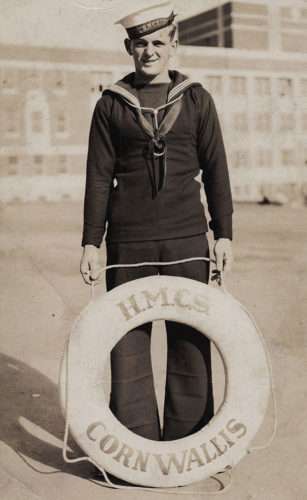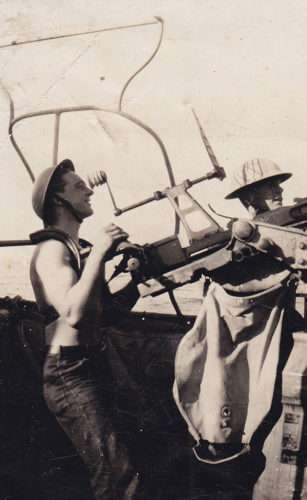
Harvey Douglas Burns during training at HMCS Cornwallis in Nova Scotia in September 1942. [Harvey Burns/The Memory Project]
Sailors in the merchant navy had cabins, shared with one shipmate. After joining the crew of HMCS Port Arthur, he asked a shipmate where he was going to sleep. “Do you see them bars up there? That’s where you hang your hammock.”
Conditions on the corvette were crowded. “The ship was made for 85 crew, and there was 105 of us aboard. You didn’t have any privacy,” said Burns in a Memory Project interview. In the washrooms, called heads, the men shared three toilets and wash bowls, “so you had to wait your turn. And there was more mealtimes than meals. When the weather was bad in the North Atlantic, they just give you a can of strawberry jam and a couple of cans of sardines and that’s what you ate.
“Half of this crew was seasick…the smell wasn’t all that good, all the portholes were closed and all the doors were closed. You didn’t get too much fresh air. We were closed up in action stations all the time.”
All that sacrifice paid off for the crew on Jan. 19, 1943, while on convoy duty in the Mediterranean Sea. Port Arthur spotted Italian submarine Tritone.

Burns aims an Oerlikon 20-millimetre cannon in October 1942. Beside him is loader Lorne Jackson. [Harvey Burns/The Memory Project]
The crew of Port Arthur not only had the satisfaction of a job well done but shared a $1,000 prize given by the community their ship was named for—Port Arthur, Ont.
The doughty corvette escorted convoys for the D-Day invasion and returned to Canada in February 1945 for a refit. Its fighting days were over, as the war ended before the repairs were complete. The ship was broken up in 1948.
Advertisement





















